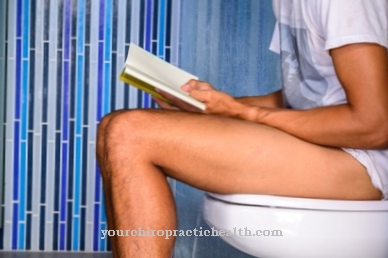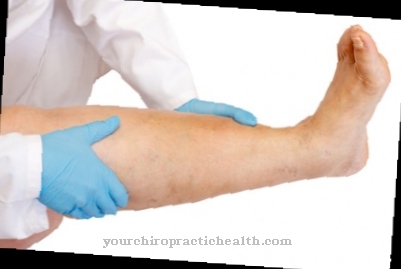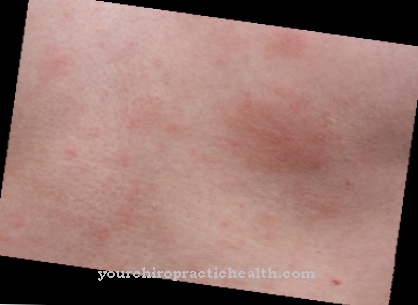In the Jaw clamp opening of the mouth is partially or completely impaired. This condition can have various, very different causes, but is generally easy to treat and reversible. However, a clamp can cause severe pain.
What is a jaw clamp?

The jaw clamp is divided into three different degrees, depending on the remaining mobility of the lower jaw. Grade I means a slight restriction, grade II a maximum mouth opening of 10 mm and grade III a maximum of 1 mm.
The decisive factor here is the so-called cutting edge distance, i.e. the distance between the upper and lower incisors. This graduation is also used to monitor the course of the disease. The jaw clamp is differentiated from the jaw lock, in which the closing of the mouth is impaired.
causes
The causes of a jaw clamp are diverse, but mostly lie in the muscles or the nerve tracts of the jaw itself. Common causes are, for example, spasms of the masticatory muscles, inflammation in the mouth and jaw area or a disc prolapse, a type of herniated disc in the temporomandibular joint.
Spasms of the masticatory muscles can be caused by a wide variety of underlying diseases, such as meningitis, epilepsy, tetanus, amphetamine abuse or tumor diseases, but they can also occur as a reaction to pain when opening the mouth. In most cases, this pain is caused by the eruption of the wisdom teeth or their surgical removal. The spasm of the masticatory muscles is a pure protective reflex.
Usually both the muscles that open the mouth and the sphincter muscles cramp. The latter, however, is much more pronounced, so that the mouth remains closed in the event of a spasm of the entire muscles in the lower jaw.
In rare cases, a mandibular fracture can also cause a clamp, for example when bone fragments limit or prevent the mobility of the lower jaw.
You can find your medication here
➔ Toothache medicationDiseases with this symptom
- Meningitis
- tumor
- epilepsy
- disc prolapse
- Tetanus
- Parotitis
Diagnosis & course
The jaw clamp is usually diagnosed by the dentist. However, it can also be determined by a general practitioner, general surgeon, or oral surgeon. The diagnosis is made based on the symptoms, i.e. that the mouth can no longer be opened.
A conduction anesthesia of the lower jaw can be carried out to confirm the diagnosis: Here, the nerve tracts that caused the spasm of the masticatory muscles as a protective reflex are switched off and the mouth can be opened again. To rule out a lower jaw fracture, an X-ray image can be made, depending on what happened.
The course after diagnosis depends entirely on the cause of the clamp. Depending on the underlying disease, it can be eliminated by the doctor within a few minutes, or lengthy treatment with medication and physiotherapy is necessary.In the vast majority of cases, a clamp is completely curable and does not cause any consequential damage.
Complications
A jaw clamp is usually easy to treat. According to current knowledge, there are no secondary diseases. The jaw clamp is very often the result of local inflammation in the temporomandibular joint when the wisdom tooth eruption is difficult. In the vast majority of cases, it disappears after the inflammation has ceased.
Very rarely, however, it can happen that a slight jaw clamp remains even after surviving the jaw inflammation. In these cases, too, complete healing is possible with the help of relaxation exercises. However, the jaw clamp can, in exceptional cases, be associated with serious illnesses. It usually occurs here as a symptom. There are no known complications as a result of a jaw clamp.
However, there are diseases in which generalized muscle spasm of the jaw muscles can occur. The mouth is spasmodically closed and can no longer be opened. A muscle spasm, which can also manifest itself in the form of a jaw clamp, is one of the many complications in these diseases.
These diseases include tetanus, meningitis, calcium deficiency in the blood, abscesses in the tonsils, neurological disorders, generalized epileptic seizures, skull base fractures or tumors of the parotid gland. In tetanus (tetanus), the jaw clamp is even one of the main symptoms. If left untreated, tetanus always leads to death due to respiratory paralysis. This disease is one of the most serious complications in which the jaw clamp plays a role.
When should you go to the doctor?
A jaw clamp is a complete or limited inability of the mouth opening to move, caused by a frozen jaw.
The diagnosis of a clamp is made by the dentist, general practitioner or oral surgeon. Depending on the cause, the patient can be cured within a few minutes. In extreme cases, treatment can take a few months and be accompanied by physical therapy. As a rule, a doctor should be consulted as soon as possible with the jaw clamp. In order to provide temporary relief from the pain, heat is suitable to relax the oral muscles. Painkillers can also provide short-term relief, but should never be combined with drugs or alcohol.
The causes can be of different nature. The jaw clamp often occurs when the jaw muscles are tense. In this case, it is advisable to visit the oral surgeon to finalize the diagnosis and, if necessary, to be referred to a physiotherapist. Special disorders also occur when swallowing and are associated with the risk of aspiration. The condition can be very painful, or at least uncomfortable for the person concerned. If it is not clear where the pain is coming from, it is advisable to see a general practitioner to rule out other reasons for the discomfort.
Doctors & therapists in your area
Treatment & Therapy
In principle, the underlying cause must always be treated with a jaw clamp. This means that, depending on the previous illness, the treatment of a jaw clamp can look very different. If there is a simple spasm of the masticatory muscles, local anesthesia of the nerve tracts can be sufficient.
However, if the cramp was caused by a disease such as meningitis or tetanus, this disease must be treated, because otherwise the masticatory muscles would cramp again when the anesthesia subsided. If inflammation is the reason, this inflammation must be combated. A single treatment at the dentist is often enough.
If the clamp is triggered by pain stimuli, a pain reliever can provide relief. If there is a seizure disorder with repeated seizures, it must be clarified neurologically whether therapy with anti-epileptic drugs makes sense.
In the event of a fracture of the lower jaw, surgical treatment may be necessary. Surgical reduction can also be carried out in the case of a disk prolapse, but a mandibular splint is often sufficient in this case.
Depending on the severity of the clamp, physiotherapy may be appropriate: This consists of various exercises to stretch the masticatory muscles in order to regain the full opening angle of the mouth. One option is to use wooden tongue depressors to expand the mouth to its maximum opening and then insert another tongue depressor. Every day one more tongue depressor is used until the original mouth opening is reached. However, this exercise must be carried out under the guidance of a specialist, otherwise the muscles can be damaged if overstretched.
Mouthwashes with warm water and irradiation of the jaw with red light can also be helpful, as the muscles relax due to the influence of heat.
Outlook & forecast
In most cases, a clamp can be treated relatively well. Since it can have many different causes, the course of the disease can also vary with the jaw clamp. In any case, the person affected must consult a doctor, as the clamp cannot be released without medical help. If the teeth or gums have been damaged as a result, a visit to a dentist is usually necessary. This can avoid pain or consequential damage.
Sometimes those affected also suffer from pain and swelling of the jaw. If an ulcer develops, a doctor must also be consulted. The patient may experience complications in the form of shortness of breath if the clamp is long and severe. Poor posture can also arise, which must be treated.
The release of the jaw clamp itself takes place without complications. Other problems with the teeth or in the oral cavity are generally treated by a dentist. In most cases the disease progresses positively.
You can find your medication here
➔ Medication for toothacheprevention
A patient can do little to prevent a clamp. If you have already suffered a jaw clamp, it is crucial to master the underlying disease that is causing it well in order to avoid recurrence.
If the clamp occurs frequently, the doctor may prescribe an antispasmodic to help control symptoms. In healthy people with no previous history, there is almost no risk of a clamp anyway, apart from accidents involving the lower jaw.
You can do that yourself
If you have a jaw clamp, you should always see a doctor. However, there are ways to help yourself that can alleviate the symptom. If pain in the jaw occurs with the jaw clamp, this can be combated briefly with the help of painkillers. The patient should, however, take care not to take them for a long period of time or with alcohol or other drugs.
Heat is suitable to relax the muscles with the jaw clamp. A hot water bottle or a heating pad can be warmed up and held on the affected area. This can lead to a relaxation of the possibly cramped muscles. It is advisable not to leave the heating pad or hot water bottle on the affected area for too long to avoid burns. Cold is just as helpful against pain. Ice cubes or a cooling pad are suitable for this. The cooling items should be wrapped in a cloth to prevent frostbite. The cold treatment can take place directly after the heat treatment.
Heavy physical activity and exertion should be avoided with the jaw clamp. In general, a doctor or dentist should also be consulted with the jaw clamp. Treatment with home remedies alone is not recommended.



.jpg)




















.jpg)



